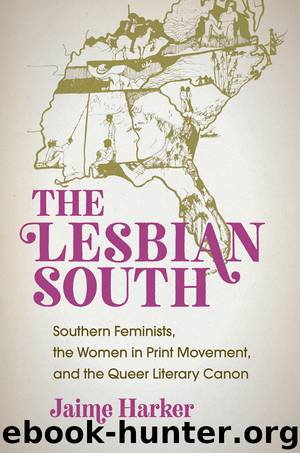The Lesbian South by Harker Jaime;

Author:Harker, Jaime;
Language: eng
Format: epub
Publisher: University of North Carolina Press
Polyamory
Polyamory was common in early lesbian feminist texts in the 1970s, and southern lesbian feminist writers continued to explore it in the 1980s. Rita Mae Brown’s irrepressible narrator from the 1973 Rubyfruit Jungle, Molly Bolt, has numerous lovers from the age of thirteen; her rejection of monogamy is part of a devil-may-care lesbian identity. When talking with her lover Holly’s older lover, Kim, she casually answers Kim’s question about her sexual relationship with Holly. Kim doesn’t mind: “Once I got beyond thirty-five I stopped being torn up about those things and I definitely gave up on monogamy. Maybe I can do it but no one else seems to be able to.” Molly answers flirtatiously, “Well, don’t test yourself. Non-monogamy makes life much more interesting”34 That attitude rules over the rest of the novel. Near the end, Molly’s first lover, now “reformed” and married unhappily to a man, asks her if she wants to settle down and what she’ll do when she gets old, and Molly answers, “I’m going to be arrested for throwing an orgy at ninety-nine and I’m not growing old with anybody. What a gruesome thought” (219). Polyandry runs through Brown’s 1978 novel Six of One as well.35 Ramelle has an affair with the Curtis, the brother of her lover Celeste, and insists that she loves them both: “I don’t feel guilty. I don’t feel I’ve betrayed her. I feel it’s the most natural thing in the world to love you. Loving you makes me love her more and loving her makes me love you. Do you think it’s possible that love multiplies? We’re taught to think it divides. There’s only so much to go around, like diamonds. It multiplies.”36 Celeste doesn’t confront Ramelle because “it was none of my business. You belong to yourself.”37 When Ramelle becomes pregnant, all three of them raise the daughter collectively.
Alice Walker’s 1982 The Color Purple, one of the best-known novels in the archive of southern lesbian feminism, grew out of a rumination on a love triangle. Walker explained: “I don’t always know where the germ of a story comes from, but with The Color Purple I knew right away. I was hiking through the woods with my sister, Ruth, talking about a lovers’ triangle of which we both knew. She said: ‘And you know, one day The Wife asked The Other Woman for a pair of her drawers.’ Instantly the missing piece of the story I was mentally writing—about two women who felt married to the same man—fell into place.”38 Love triangles structure most of the relationships in the novel, and they are often overlapping: Albert, Shug, and Celie; Albert, Shug, and Grady; Celie, Shug, and Germaine; Harpo, Sophia, and Mary Agnes (Squeak); Harpo, Sophia, and Buster; Corrine, Samuel, and Nettie. As Linda Abbandonato puts it, “Triadic combinations proliferate; characters are constantly realigned in an intricate network of combinations, apparently in a continual state of metamorphosis until the final utopian vision.”39 The novel frames these multiple relationships as, simply, “family.” When
Download
This site does not store any files on its server. We only index and link to content provided by other sites. Please contact the content providers to delete copyright contents if any and email us, we'll remove relevant links or contents immediately.
| Ancient & Classical | Arthurian Romance |
| Beat Generation | Feminist |
| Gothic & Romantic | LGBT |
| Medieval | Modern |
| Modernism | Postmodernism |
| Renaissance | Shakespeare |
| Surrealism | Victorian |
4 3 2 1: A Novel by Paul Auster(11052)
The handmaid's tale by Margaret Atwood(6854)
Giovanni's Room by James Baldwin(5879)
Big Magic: Creative Living Beyond Fear by Elizabeth Gilbert(4723)
Asking the Right Questions: A Guide to Critical Thinking by M. Neil Browne & Stuart M. Keeley(4576)
On Writing A Memoir of the Craft by Stephen King(4214)
Ego Is the Enemy by Ryan Holiday(3991)
Ken Follett - World without end by Ken Follett(3973)
The Body: A Guide for Occupants by Bill Bryson(3802)
Bluets by Maggie Nelson(3711)
Adulting by Kelly Williams Brown(3671)
Guilty Pleasures by Laurell K Hamilton(3587)
Eat That Frog! by Brian Tracy(3514)
White Noise - A Novel by Don DeLillo(3436)
The Poetry of Pablo Neruda by Pablo Neruda(3367)
Alive: The Story of the Andes Survivors by Piers Paul Read(3311)
The Bookshop by Penelope Fitzgerald(3228)
The Book of Joy by Dalai Lama(3218)
Fingerprints of the Gods by Graham Hancock(3214)
